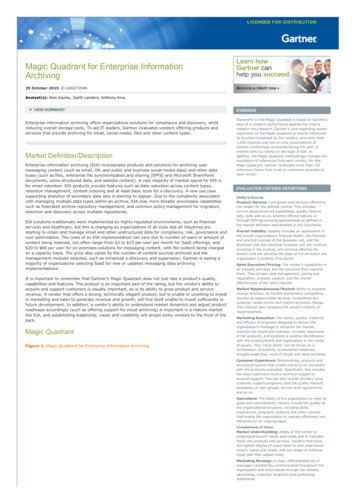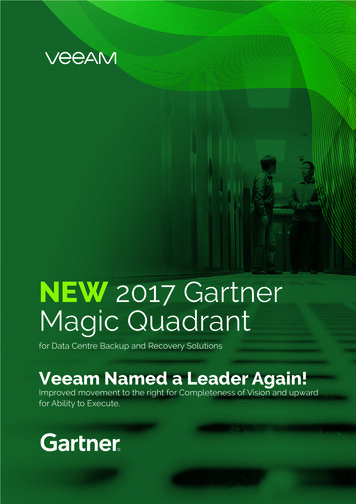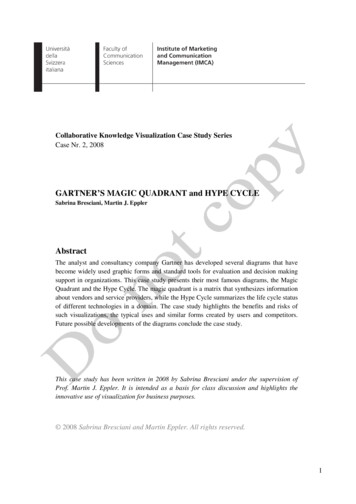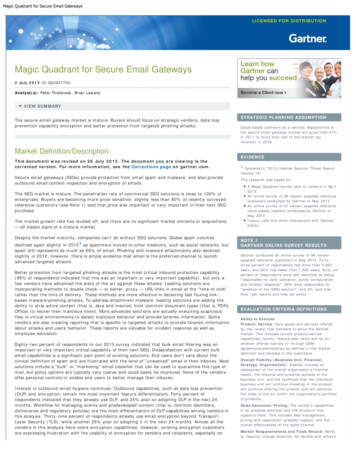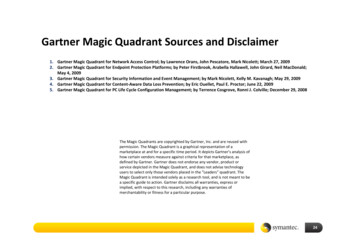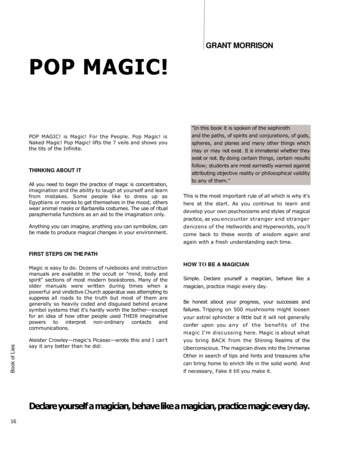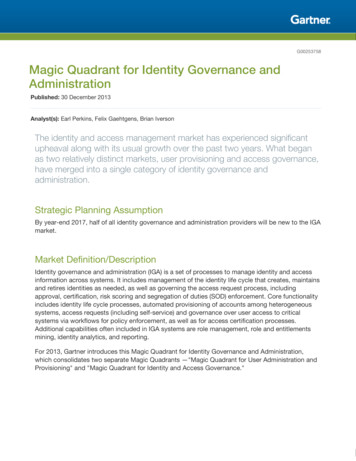
Transcription
9/9/13Magic Quadrant for Data Center Network InfrastructureMagic Quadrant for Data Center NetworkInfrastructure11 February 2013 ID:G00235303Analyst(s): Mark Fabbi, Tim ZimmermanVIEW SUMMARYThe requirements for data center networking equipment have evolved rapidly, with emergingtechnologies increasingly focused on supporting more automation and simplified operations withina virtualized data center. This new Magic Quadrant focuses on how vendors are meeting theemerging requirements.Market Definition/DescriptionRequirements for data center networking equipment have evolved rapidly during the past fouryears after a period of architectural stability that lasted at least 15 years. While speed, densityand scale increased during that period, the underlying, oversubscribed three-tier hierarchicalapproach — using end-of-row switches, an aggregation layer and intelligent layer three-coreswitching — was largely unchanged. Also during this period, common chassis switches were usedin the data center, core campus and workgroup closet. The data center network market has beentransformed with new architectures, new technologies and vendors specifically targeting solutionsto address the changing size and density of the data center, shifts in traffic patterns, and theincreasing requirement to simplify network operations.What's Changed?First, the size and density of data centers are changing, with three macrolevel trends driving bothexpansion and contraction of data centers:1. Server and data center consolidation. IT organizations continue to centralize computeresources and reduce the number of physical data centers resulting in fewer, but largercorporate data centers.2. Increasing compute density using multicore, multisocket servers combined withvirtualization are reducing the physical footprint required. Workloads that used to takemultiple racks of servers are now being delivered within a portion of a single rack.3. The migration of applications toward external cloud services also reduces the spacerequirements within the corporate data center.Second, traffic patterns are shifting within modern data centers, from one where the north-southtraffic (or that from the server through the core out to users) was the predominant traffic flow toone where east-west traffic (between applications) now predominates. This has been driven bydistributed and tiered application architectures.Third, the desire for more service-based IT offerings, driven by increasingly real-time businessrequirements, has put a spotlight on manual network operations procedures. Automatedapplication provisioning allows applications to be rapidly deployed, but the "human middleware"of network operations can delay deployment for days or weeks.What Is Required in New Data Center Network Solutions?These trends all have major implications for data center networking solutions. The increasingdensity (regardless of whether a data center is expanding or contracting) drives the need forhigher-speed interfaces. New server connections are now mainly 10 Gigabit Ethernet (GbE), withuplinks from top of rack (ToR) or blade switches quickly migrating to 40 GbE. The use ofvirtualization drives the first level of aggregation into the virtual switch, which drives higherutilization on these faster links, eliminating the need for physical aggregation switches. Thehigher density and virtual switch aggregation means that ToR and blade switches are a better fit,rather than the former end-of-row solution. Another related capability is the ability to scale downas well as up, which requires cost-effective, rightsized data center networks and alternative formfactors.Applications are now more distributed, not physically tied to specific server hardware or within asingle rack, and are more elastic in their deployment as they utilize compute and storageresources in the data center. With no physical dependency for network connections, it is moredifficult to specify network requirements, which is the leading driver toward integrating virtualinput/output (I/O) and storage gateway capabilities into the ToR or blade switch.The increasing requirement to efficiently deal with east-west traffic has resulted in newapproaches, including higher-performance, low-latency switches, the emergence of one- or twotier architectures, flexible fabric architectures using technologies such as TransparentInterconnection of Lots of Links (TRILL) and Shortest Path Bridging (SPB), and more intelligenceand traffic forwarding at the server edge of the data center network (through the use of virtualchassis or chassis clustering solutions). All these approaches improve server-to-serverperformance and, in some cases, move the network toward providing a homogeneous set ofcapabilities for all connected compute resources. For data center networks, it is imperative towww.gartner.com/technology/reprints.do?id 1-1E1TR4Z&ct 130211&st sbEVALUATION CRITERIA DEFINITIONSAbility to ExecuteProduct/Service: C ore goods and se rvice soffe re d by the ve ndor that com pe te in/se rve thede fine d m ark e t. This include s curre ntproduct/se rvice capabilitie s, quality, fe ature se ts,sk ills and so on, whe the r offe re d native ly orthrough O EM agre e m e nts/partne rships as de fine din the m ark e t de finition and de taile d in thesubcrite ria.Overall Viability (Business Unit, Financial,Strategy, Organization): Viability include s anasse ssm e nt of the ove rall organization's financialhe alth, the financial and practical succe ss of thebusine ss unit, and the lik e lihood that theindividual busine ss unit will continue inve sting inthe product, will continue offe ring the product andwill advance the state of the art within theorganization's portfolio of products.Sales Execution/Pricing: The ve ndor's capabilitie sin all pre sale s activitie s and the structure thatsupports the m . This include s de al m anage m e nt,pricing and ne gotiation, pre sale s support, and theove rall e ffe ctive ne ss of the sale s channe l.Market Responsiveness and Track Record: Abilityto re spond, change dire ction, be fle x ible andachie ve com pe titive succe ss as opportunitie sde ve lop, com pe titors act, custom e r ne e ds e volveand m ark e t dynam ics change . This crite rion alsoconside rs the ve ndor's history of re sponsive ne ss.Marketing Execution: The clarity, quality,cre ativity and e fficacy of program s de signe d tode live r the organization's m e ssage to influe ncethe m ark e t, prom ote the brand and busine ss,incre ase aware ne ss of the products, and e stablisha positive ide ntification with the product/brandand organization in the m inds of buye rs. This"m ind share " can be drive n by a com bination ofpublicity, prom otional initiative s, thoughtle ade rship, word-of-m outh and sale s activitie s.Customer Experience: R e lationships, productsand se rvice s/program s that e nable clie nts to besucce ssful with the products e valuate d.Spe cifically, this include s the ways custom e rsre ce ive te chnical support or account support. Thiscan also include ancillary tools, custom e r supportprogram s (and the quality the re of), availability ofuse r groups, se rvice -le ve l agre e m e nts and so on.Operations: The ability of the organization tom e e t its goals and com m itm e nts. Factors includethe quality of the organizational structure ,including sk ills, e x pe rie nce s, program s, syste m sand othe r ve hicle s that e nable the organization toope rate e ffe ctive ly and e fficie ntly on an ongoingbasis.Completeness of VisionMarket Understanding: Ability of the ve ndor tounde rstand buye rs' wants and ne e ds and totranslate those into products and se rvice s.Ve ndors that show the highe st de gre e of visionliste n and unde rstand buye rs' wants and ne e ds,and can shape or e nhance those with the ir adde dvision.Marketing Strategy: A cle ar, diffe re ntiate d se t ofm e ssage s consiste ntly com m unicate d throughoutthe organization and e x te rnalize d through thewe bsite , adve rtising, custom e r program s andpositioning state m e nts.Sales Strategy: The strate gy for se lling productsthat use s the appropriate ne twork of dire ct andindire ct sale s, m ark e ting, se rvice , andcom m unication affiliate s that e x te nd the scopeand de pth of m ark e t re ach, sk ills, e x pe rtise ,te chnologie s, se rvice s and the custom e r base .Offering (Product) Strategy: The ve ndor'sapproach to product de ve lopm e nt and de live rythat e m phasize s diffe re ntiation, functionality,m e thodology and fe ature se ts as the y m ap to1/10
9/9/13Magic Quadrant for Data Center Network Infrastructurefocus on functional requirements, as opposed to debating emerging standards. Key criteria toconsider include:Simply and seamlessly add bandwidth via links and nodes.Instantiate services (Layer 2, Layer 3 and above) at any point within the network.Have consistent and homogeneous capabilities across the fabric.Implement the fabric in such a way as to simplify ongoing management and operations.Support performance that can cost-effectively scale down as well as up.Finally, the move to simplifying network operations is also driving innovations, including single-tierdata center switching solutions, autoconfiguring network fabrics and increasing integration ofnetwork operations with application provisioning tools. Automation in the data center has had amajor impact on data center operations and expectations are that the network will become partof a more coordinated virtual architecture. More recently, we have seen rapidly increasing interestin exploiting the broad network virtualization capabilities and open interfaces delivered withsoftware-defined networking (SDN) solutions. Moving away from 40-year-old network operationsinterfaces is arguably the biggest transformational benefit when looking to modernize a datacenter network architecture.curre nt and future re quire m e nts.Business Model: The soundne ss and logic of theve ndor's unde rlying busine ss proposition.Vertical/Industry Strategy: The ve ndor'sstrate gy to dire ct re source s, sk ills and offe rings tom e e t the spe cific ne e ds of individual m ark e tse gm e nts, including ve rtical m ark e ts.Innovation: Dire ct, re late d, com ple m e ntary andsyne rgistic layouts of re source s, e x pe rtise orcapital for inve stm e nt, consolidation, de fe nsive orpre -e m ptive purpose s.Geographic Strategy: The ve ndor's strate gy todire ct re source s, sk ills and offe rings to m e e t thespe cific ne e ds of ge ographie s outside the "hom e "or native ge ography, e ithe r dire ctly or throughpartne rs, channe ls and subsidiarie s asappropriate for that ge ography and m ark e t.Return to TopMagic QuadrantFigure 1. Magic Quadrant for Data Center Network InfrastructureSource: Gartner (February 2013)Return to TopVendor Strengths and CautionsAlcatel-LucentAlcatel-Lucent is a strong player in service provider networking, voice technologies, applicationsand services, and it continues to expand its data network portfolio and reach. The introduction ofits enterprise data center switching mesh extends its Application Fluent Network strategy into thedata center to address customer elasticity, performance and oversubscription requirements.Alcatel-Lucent has made a concerted effort to extend itself geographically. The vendor should beon the shortlist for midsize enterprise and large European infrastructure decisions, withconsideration for other geographical areas as well.StrengthsAlcatel-Lucent augmented its Application Fluent Network strategy by focusing onperformance, scalability and elasticity, with the introduction of wire rate 10 GbE and 40 GbE,virtual chassis and data center bridging to the enterprise data center mesh architecture. Thevendor's WAN and optical networking product offerings also give Alcatel-Lucent the tools toaddress data-center-to-data-center switching requirements.By focusing on switching as a core competency, Alcatel-Lucent has developed an ecosystemto address the additional components needed for an end-to-end solution. This means it isnot overextending its resources into computing, storage or server virtualization but addingwww.gartner.com/technology/reprints.do?id 1-1E1TR4Z&ct 130211&st sb2/10
9/9/13Magic Quadrant for Data Center Network Infrastructurevalue to its partnerships where it does not provide the core competency.The Alcatel-Lucent architectural vision in the data center also extends to networkapplications, such as Virtual Network Profile (vNP), which not only supports virtualizedworkloads, but also expands to understand the needs of the application, includingprovisioning requirements, access control rights and expected quality of service.CautionsCompared with a number of other vendors in this Magic Quadrant, Alcatel-Lucent data centerrevenue is relatively small (although growing quickly) and recent corporate restructuringefforts raise the issue of which technologies the vendor will continue to invest in.The vendor continues to have solid capabilities, but limited marketing communications havereduced the company's visibility. This means that it is not considered for all potentialopportunities in its target markets and geographies.While Alcatel-Lucent has expanded its resources and support to target geographies such asNorth America, enterprises should vet local support both for sales and technical services aspart of the evaluation process.Return to TopArista NetworksArista Networks is the best example of a vendor targeting the emerging needs of highperformance data centers and illustrates strong evidence that the data center network market isa separate independent market. The vendor has focused on building highly efficient, easy-tomanage network technologies that have clearly improved the price/performance expectations inthe data center. Its standards-based solutions and growing ecosystem allow Arista Networks toplay a role in an increasing range of deployments, and it will be key for the vendor to continue tomove from its strengths in the high-performance computing, high-end cloud and financial servicesmarkets into the mainstream market. Expansion into the Asia/Pacific region helps the vendoraddress the needs of global organizations. Arista Networks should be considered for data centersin which there is a need to optimize performance and latency.StrengthsA dedicated focus on high-performance data center networking has allowed Arista Networksto deliver solutions for the key challenges of performance and latency.The vendor has leveraged merchant silicon combined with strong engineering to drive newtechnologies and performance levels into the market.Recent innovations, such as Arista Networks' VXLAN gateway, bring key functionality and agrowing ecosystem into the SDN marketplace, and the vendor's low-latency 7124FXApplication Switch brings unique custom application features to the market.CautionsWhile emerging as a key data center vendor, Arista Networks is still very targeted in itsapproach to the market and may not be ideally suited to all data center requirements.While the vendor has a growing global sales and support presence in EMEA and theAsia/Pacific region, its business is largely concentrated in North America. Enterprises shouldensure the appropriate levels of local support when looking at international deployments.Return to TopAvayaAvaya continues to make investments in its data networking portfolio and the launch of VirtualEnterprise Network Architecture (VENA) in 2011 allowed the vendor to compete for nextgeneration data centers with a highly robust architecture. The fabric solutions in VENA addressnot only data center requirements, but also extend to the campus as well. Although we currentlysee a strong corporate commitment to data networking, the future success of Avaya is notdependent on data networking, which raises long-term concerns in light of the vendor's mixedresults and waning influence in the data networking market. Enterprises looking to expandexisting Avaya data center solutions or considering an end-to-end unified communications andcollaboration (UCC) platform that includes the enterprise network should consider Avaya.StrengthsThe vendor has a large installed base of data center network solutions, with a strong historyof providing highly resilient data center network architectures.Avaya has made investments in VENA and has worked to leverage its UCC salesorganization and customer base to expand its footprint in North America.VENA's architecture extends beyond the data center to the campus network, providing aseamless end-to-end enterprise solution.CautionsDeclining market share has meant that Avaya's influence in data networking has waned andthat Avaya does not get an opportunity to compete for many data center networkingopportunities.Increasingly limited financial resources, distribution and market support continue to putpressure on Avaya's abilities in this market.Return to TopBrocadeBrocade has depth of expertise across all data center networking technologies. The VDX 6700family of switches and VDX 8770 chassis switches deploying the vendor's Virtual Cluster Switching(VCS) architecture provides a solid data center solution, including native integration of SANwww.gartner.com/technology/reprints.do?id 1-1E1TR4Z&ct 130211&st sb3/10
9/9/13Magic Quadrant for Data Center Network Infrastructureconnectivity. Brocade has been growing at roughly market rates for the past year, but historicallylimited marketing means that its brand does not get the exposure that could assist in it beingadded to more shortlists. The vendor should be considered for the shortlists of all data centernetwork infrastructures and large cloud providers.StrengthsThe VCS solution is a well-thought-out Ethernet fabric offering for virtualized data centers.The product family provides 1 GbE, 10 GbE and 40 GbE capabilities, with future 100 GbEsupport. Key VCS features include simplified and largely automated operations, such as selfconfiguring links and switches and fabric support for virtual machine (VM) mobility.The "pay as you grow" model supported in the VDX family allows customers to pay for onlythe required capacity, either through port-based licensing or a monthly subscription, whichprovides additional differentiation and enhances Brocade's data center vision.A scale-out architecture with entry-level pricing allows Brocade to appropriately rightsizedata center solutions for a wide range of use cases.CautionsCoverage remains a challenge for Brocade, especially in the Asia/Pacific region, as it rampsup its direct sales force as the predominant approach for data center opportunities.While the VCS fabric is a strong architectural solution, Brocade was initially slow in providinga broad range of VDX platforms, which limited its initial opportunities. The portfolio has beenrecently extended to include a range of chassis and fixed-format switches.Clients need to ensure that Brocade is able to support new data center requirements andcapabilities in their geographies, because Brocade's revenue is skewed toward the U.S.market, although it does have reference accounts in all regions.Return to TopCiscoCisco has the largest collection of data center networking products, ranging from large chassiscore, aggregation, virtual switches, access port aggregators (Fabric Extender [FEX]) and customlow-latency solutions, combined with a range of network scalability features (such as FabricPath,Virtual PortChannel [vPC] and Overlay Transport Virtualization [OTV]). However, Cisco has notbeen able to knit this vast array of capabilities into a cohesive strategic portfolio, and, in manycases, leaves its customers confused about the appropriate solution required, especially when itinvolves a migration from an existing Cisco Catalyst solution. We are also concerned with Cisco'sreliance on its FEX architecture as its preferred data center offering. While this does reducemanagement complexity, it comes at the expense of centralizing all traffic flows and reducesperformance for the increasing amount of east-west traffic in modern data centers. Cisco shouldbe considered for all data center network opportunities globally.StrengthsThe vendor has the widest selection of data center products and technologies that covermost, if not all, requirements in the data center.Innovations such as Virtual Device Contexts (VDCs) and the use of the Nexus 5500 Series ascore switches help reduce footprint and cost in midsize data centers.Cisco has a huge installed base of largely loyal customers, as well as a strong channel thatclearly helps the vendor migrate to its newer Nexus technologies and architectures.CautionsAlthough still the dominant player (with 71% revenue share and 58% port share), Cisco lost8% revenue market share during 2011, with declining year-over-year revenue. Whilerevenue growth appears to have returned in 2012, market share declines and input fromclient inquiries illustrate the increasing competitiveness in this market, and Cisco's challengesin delivering compelling, cost-effective solutions.Software licensing costs can often result in additional costs that further challenge Cisco'sability to compete with alternative approaches.Clients need to test their configurations and software revisions to address reportedsoftware reliability concerns in some complex environments with the Nexus 7000 and Nexus1000V families. Organizations encountering problems in these areas should work closelywith Cisco Technical Assistance Center (TAC) to ensure they have deployed and upgraded toappropriate software releases and configurations.Cisco has still not adequately addressed upper-layer services within the Nexus portfolio, andhas also been slow in delivering technologies such as 40 GbE for ToR switches in itsmainstream Nexus 5500 family.Return to TopDellDell's acquisition of Force10 Networks has extended the depth of Dell's expertise across all datacenter networking technologies through its internal server capabilities, leveraging its switchingacquisition and utilizing storage relationships that can be deployed as a "data center in a chassis"or built as a fabric. Dell quickly integrated Force10 switching into its PowerEdge M-series bladeserver chassis and has clearly invested in building its networking presence. Dell should beconsidered for the shortlists of enterprise data centers, especially if PowerEdge servers are beingconsidered or custom implementations are needed for private cloud opportunities.StrengthsThe Dell Force10 offering has a broad portfolio and strong road map for clients that arelooking for consistent performance, and energy-efficient and price competitive componentswith the ability to be deployed in private or public cloud solutions.Large enterprises and cloud infrastructure providers can expect a strong direct model withwww.gartner.com/technology/reprints.do?id 1-1E1TR4Z&ct 130211&st sb4/10
9/9/13Magic Quadrant for Data Center Network InfrastructureDell; its Data Center Solutions group targets high-end customers and offers custom designand manufacturing capabilities as an end-to-end data center solutions provider.Dell has a strong focus on network automation, and that allow enterprises to simplify andintegrate network operations into broader data center management processes.Customer support remains a strength with Dell references.CautionsDell needs to continue to broaden its portfolio to deliver a more complete convergence ofdata and storage networking (especially for ToR switches), and to better articulate andfurther develop a more comprehensive SDN strategy.Dell needs to extend its marketing and awareness of the new Active System architecture,and to better leverage its strengths in servers and storage, to take advantage of itsincreasing capabilities in this market.As a smaller and relatively new player in data center networks, Dell lacks an enterprisenetwork installed base that is often leveraged by market leaders.Return to TopEnterasys NetworksEnterasys Networks has introduced OneFabric, an architecture that spans from the data center tothe edge of the network, with management and policy enforcement across the entire networkinfrastructure. The vendor has a strong technical solution and an industry-leading lifetimewarranty. While it continues to invest in marketing, Enterasys Networks remains a smaller vendorin the market and clearly needs to articulate its differentiation to expand its presence in theenterprise. Enterasys should be considered for enterprise data centers in North America, LatinAmerica and Western Europe.StrengthsThe data center to network edge management offered by Data Center Manager (DCM) andthe policy enforcement capabilities of OneFabric Control Center allow a single pane of glassfor midsize enterprises for server and storage virtualization.The S-Series chassis switch and 7100-Series ToR, combined with virtual switch bonding(VSB), provide scalability that can be leveraged for enterprises that will grow from 100 tomore than 2,000 servers.Enterasys' vision includes APIs integrated into DCM, and its CoreFlow2 technology in its datacenter switches allows for future SDN expansion and the ability to leverage application-levelvisibility.CautionsThe vendor continues to have a small market footprint, with 1% to 2% market share, and itis somewhat geographically limited to North America, Latin America and Western Europecoverage.While Enterasys continues to invest in marketing and has added more than 100 partners,Gartner does not see it represented outside of its core markets.Return to TopExtreme NetworksExtreme Networks' Open Fabric Data Center solution uses its BlackDiamond X8 and Summitswitches for its data center architecture, and leverages ExtremeXOS software and industrystandards for management and application integration. The BlackDiamond and Summit productlines focus on high-performance, low-latency and scalable switching solutions, which are solidcomponents of the vendor's data center architecture, but Extreme Networks is still one of thesmaller vendors in the market. The vendor should be considered in North America and Japan, or intarget markets such as higher education.StrengthsThe ability for the Extreme BlackDiamond platform to deliver 1 GbE/10 GbE/40 GbEfunctionality and a road map to support 100 GbE in the data center have the vendor poisedto address enterprises in the most demanding environments.In conjunction with ExtremeXOS, the Ridgeline element manager and XNV provideorchestration as well as provisioning of virtualization capabilities across the fabric, whichallow for policy enforcement differentiation in the data center.Extreme Networks offers dynamic power management with its fabric switches through itsUniversal Port Manager, which optimizes power usage.CautionsIn 2012, Extreme Networks continued to struggle to demonstrate a presence in the datacenter and was not seen on shortlists outside of its limited target market. It isgeographically limited to North America and Japan.The vendor has solid data center capabilities, but limited marketing communications, thuslimiting company visibility and differentiated messaging. This severely limits its opportunitiesand its ability to expand both product offerings and investments in new target markets.Return to TopHPHP continues to enhance its data center networking capabilities, especially focusing on networkmanagement and automation. It leads the established networking vendors with its stronginvestments in and delivery of SDN and OpenFlow solutions, and its Virtual Application Networkssolution can streamline network configuration from the data center to the desktop. HP's datawww.gartner.com/technology/reprints.do?id 1-1E1TR4Z&ct 130211&st sb5/10
9/9/13Magic Quadrant for Data Center Network Infrastructurecenter network revenue jumped 60% during 2011 (to 750 million), gaining nearly 4% of revenuemarket share, and we observed continued momentum during 2012. HP should be considered forthe shortlists for all data center networking requirements, especially for organizations looking tosimplify network operations and take advantage of SDN as part of their data center networkevolution.StrengthsThe vendor offers a broad set of data center network technologies, running from serveraccess to highly scalable core chassis solutions.HP Networking has demonstrated leadership and a major commitment to integrating SDNand OpenFlow into its portfolio and delivering commercial-ready SDN solutions.HP Intelligent Management Center (IMC) allows HP Networking technology to be easilyintegrated into an incumbent networking solution through the use of strong multivendormanagement capabilities. The addition of Virtual Application Networks solutions furtherreduces the operational burden within the data center and campus network.CautionsThe vendor has been slow in introducing a next-generation fabric technology (based onTRILL) to its solution, which we expect will be combined with its Intelligent ResilientFramework (IRF) technology to deliver a highly scalable data center fabric.HP Networking has not aggressively taken advantage of both the technology and footprintprovided by Virtual Connect, missing out on many opportunities to expand its data centernetwork opportunities.Some HP channels can be relatively weak in representing the vendor's network solution.Organizations that are considering HP should ensure that their channels have appropriatelevels of HP Networking experience.Return to TopHuaweiHuawei made a major investment in enterprise data networking technologies starting in 2011,and has ramped up a broad portfolio to address data center infrastructure requirements, as wellas providing scalable security platforms in the data center. While corporately global in scale andreach, the vendor's data center products are primarily delivered in China, the Asia/Pacific regionand other emerging markets, with a plan to increase its coverage and target market
Magic Quadrant Figure 1. Magic Quadrant for Data Center Network Infrastructure Source: Gartner (February 2013) Return to Top Vendor Strengths and Cautions Alcatel-Lucent Alcatel-Lucent is a strong player in service provider networking, voice technologies, applications and services, and it continues to expand its data network portfolio and reach.
